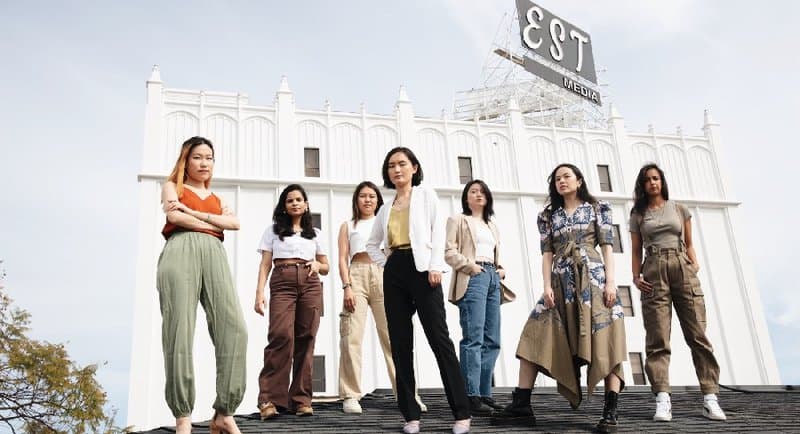Eastern Standard Times (EST) celebrated its launch in Australia last month with a delicious dinner by Kylie Kwong at her Eveleigh restaurant Lucky Kwong. Hosting the event was the publication’s editor-in-chief Keshia Hannam.
Hannam spoke to Mediaweek about the importance of an all-Asian editorial team, her hopes for the publication, and the need for Asian representation in the media.
EST was established in 2021 by artist and entrepreneur Jaeson Ma and Eric Tu, formerly of VICE and Anonymous Content. Hannam joined the team in September 2021 as editor-in-chief as the publication launched in the US and its continued expansion to Australia.
“We started because there is no global media company based in Asia and telling stories from the Asian lens like there is in the US/UK (BBC, CNN, WSJ etc). I noticed this acutely when living and working in Hong Kong. We believe it’s time to change that,” she said.
The EST newsroom has seven full-time staff members across Los Angeles and New York and lead producers based in capital cities across Asia and now Sydney.
Hannam noted that Asian narratives in Australia and around the world have been told and controlled by those who have not lived their stories. She said: “Asia is frequently portrayed as one monolithic culture when in fact there are many different cultures, languages and stories that make up the continent.”
The editor-in-chief also added that while Asians make up 16% of the Australian population, the majority disparity with the representation of people of colour on local screens. She cited a 2019 Media Diversity Australia study that found only 6% of presenters, commentators and reporters come from an Indigenous or non-white background.
“For too long, stories have been told through a Western lens about the East and the Asian experience in Western markets — we’re here to redress that narrative. That starts by ensuring the people sourcing, writing, and producing them come from those backgrounds,” she said.
Hannam said having an all-Asian editorial team allows them to ideate and receive pitches for stories that other newsrooms may not cover or present a new angle to an issue already getting a lot of attention in the media.

Pictured left to right: Joy Jeong (S Korea), Manal Ahmed (Pakistan), Maggie Teng (Taiwan), Ruolin Luyo (China), Ella Chi (China), Stephanie Tangkilisan (Indonesia) and Keshia Hannam (Australia/Hong Kong/India)
What makes Eastern Standard Times unique?
On the surface, the publication may draw similarities with the likes of Vice Asia. However, Hannam pointed out three main ways that make EST unique.
EST is a video-only platform; all the content produced is optimised for the web, making their content efficient and allowing for imaginative storytelling.
The editor-in-chief noted that their stories are created for and by Asians, from producing to shooting and editing. “We work with teams on the ground in each city we are telling the story to ensure ‘parachute journalism’ is never relied on,” she said.
The EST newsroom comprises Asian women born and raised in Asia and now work in Diaspora markets. Hannam explained: “We believe this is important to correct narratives that are everything from stereotypical to harmful, as well as lends more nuance, humanity and empathy to our characters, a rarity in the publishing world outside of women’s lifestyle magazines. We do not reduce stories to soundbites but work to contextualise as much as we can.”
Creating inspiring and inclusive content
The editor-in-chief hopes the EST will inspire the next generation of young Asian-Australians to see themselves represented by the publication and consider a career in media and journalism.
“This is something I never had growing up in Queensland as an East Asian-born, Indian-Australian woman,” she said.
Hannam noted that as an inclusive publication, she hopes people from non-Asian backgrounds also resonate with the content. “In a country like Australia where the media landscape is dominated by pretty much two major players — News Corp and Fairfax — there’s a real need for independent journalism like Eastern Standard Times.
“Aside from covering stories that the bigger players wouldn’t necessarily pick up on, non-Asians will have loads to learn by exposing themselves to authentic stories told from a viewpoint that differs from their own lived experiences.
“By listening to others, and realising how human we all are, no matter our differences, we can better understand each other, which is precisely how progress is made. Narrative change is where behaviour change begins,” she added.
Hannam also noted that Australians are hungry for different stories and storytellers. She said: “Many stories are overlooked in traditional Western media that claim ‘objectivity’. Or, issues already receiving media attention can lack important context. We want to provide both.”
In the long-term, her hope for EST is to provide visibility and opportunities for many Asian communities and that the voices in newsrooms across Australia and the West are a “better reflection of the people consuming them.”

The outlook for Eastern Standard Times in the year ahead
EST has completed its first phase – launching in Asia and starting from the perspective of Asians in their motherlands. The publication is currently in its second stage, focusing on the US and Australian markets, which boast two of the largest Asian migration populations and where first-generation Asian immigrants seek their lived experiences in the media they consume.
The third, which will happen toward the end of the year, will focus on overlooked regions in Asian cultures, such as the Chinatowns of Madagascar and Mauritius, mixed-cuisine restaurants of Mexico City, and the refugee populations in Denmark.
“We hope to start building our teams across this region too, though remote production is completely viable and has given us a competitive advantage to build quickly across the world,” Hannam said.
–
Top image: Keshia Hannam
